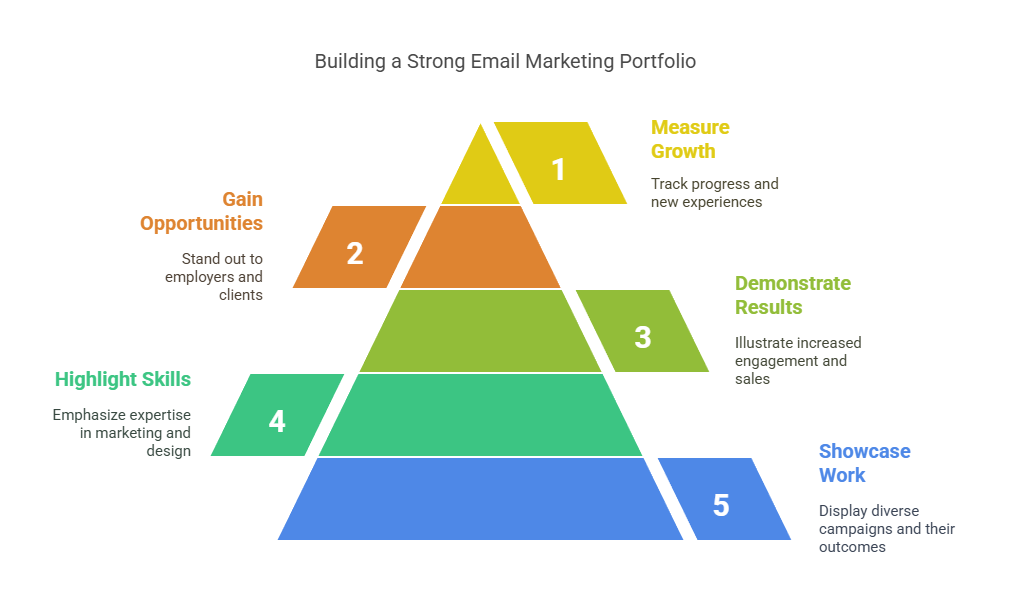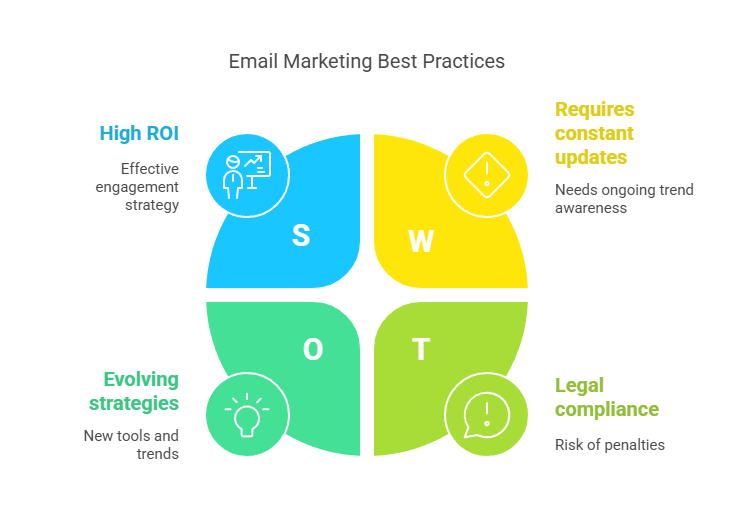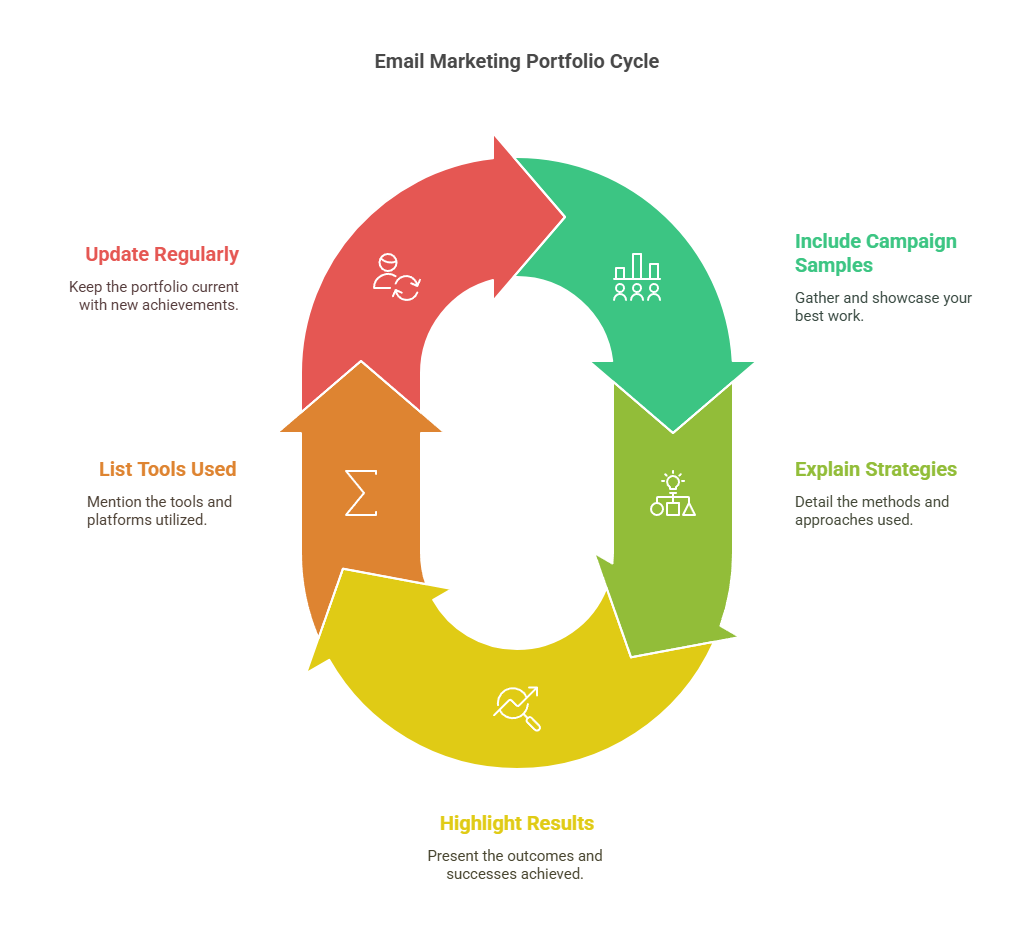Email marketing is a powerful tool that helps businesses reach customers and grow. It’s not just about sending out messages; it’s about creating a strategy that engages people and builds long-lasting relationships. An email marketing portfolio is a collection of your work that showcases the campaigns you’ve managed, the results you’ve achieved, and the skills you’ve developed.
In this blog post, we will explore the concept of an email marketing portfolio, how to create one, and why it’s essential for your marketing career. Whether you’re just starting or looking to improve your skills, this guide will provide valuable insights.
What is an Email Marketing Portfolio?
An email marketing portfolio is a collection of your email marketing campaigns, strategies, and results. It’s a way to demonstrate your expertise to potential employers or clients. This portfolio shows what you can do and the results you can achieve. It includes the types of emails you’ve sent, the strategies used, and how effective those campaigns were in reaching their goals.
A well-organized portfolio can help you land new clients, get hired for marketing roles, or simply track your own progress.
Why is an Email Marketing Portfolio Important?
Building a portfolio is important for several reasons. First, it shows proof of your experience. Second, it helps you track your progress over time. Third, it’s a great tool for demonstrating your skills to others. A strong portfolio can set you apart in a competitive market.
Key benefits of an email marketing portfolio:
-
Showcase Your Work: You can show the different campaigns you’ve worked on and their results.
-
Highlight Your Skills: A portfolio highlights your expertise in email marketing, design, and strategy.
-
Demonstrate Results: Show how your campaigns increased engagement, sales, or website traffic.
-
Gain New Opportunities: A strong portfolio helps you stand out to employers and clients.
-
Measure Your Growth: As you gain experience, you can update your portfolio with new projects.
How to Create an Effective Email Marketing Portfolio
Creating an email marketing portfolio doesn’t have to be difficult. Here are some steps to help you build an effective portfolio:
1. Gather Your Work Samples
The first step in creating your portfolio is collecting your email marketing work. Include the emails you’ve designed and sent out. Focus on emails that had a positive impact on your business or client.
Some examples of work to include are:
-
Email Newsletters: Showcase your designs and content.
-
Promotional Emails: Show how you created offers that boosted sales.
-
Automated Campaigns: Demonstrate your ability to set up triggered emails based on user behavior.
-
Re-engagement Campaigns: Show how you’ve successfully re-engaged dormant subscribers.
2. Explain the Strategy Behind Each Campaign
For each sample, explain the strategy you used. Discuss the target audience, goals, and results. This will show your understanding of the email marketing process.
For example, if you sent out a promotional email, explain the offer, the timing, and how it was tailored to the audience. Include key metrics like open rates, click-through rates, and conversion rates. These metrics demonstrate the success of your campaign.
3. Showcase Your Tools and Platforms
In your portfolio, include the email marketing tools you’ve used, such as Mailchimp, Constant Contact, or HubSpot. This will show your familiarity with popular platforms in the industry.
Each tool has its strengths, so mentioning the platforms you’ve worked with shows your versatility and readiness to adapt to different systems.
4. Display Visual Examples
Visuals can speak louder than words. Include screenshots of your email templates, landing pages, and analytics dashboards. Displaying your designs and content will make your portfolio more engaging.
Make sure to get permission before using client work or confidential information. If you can’t use actual campaign visuals, consider creating mock-ups or demos of your work.
5. Include Testimonials or Case Studies
Client testimonials or case studies can give your portfolio more credibility. If you’ve worked with clients, ask them for feedback on how your campaigns performed. This helps show that you can deliver real results.
Case studies provide an in-depth look at the process behind the campaign. Include details about the campaign objectives, strategies, and the results. This shows your ability to think strategically and measure outcomes.
6. Organize Your Portfolio
Keep your portfolio organized. You can divide it into sections based on the type of campaigns, industries, or tools you’ve used. This will make it easier for someone reviewing your portfolio to understand your experience.
For example:
-
Email Newsletters
-
Promotions and Offers
-
Automated Campaigns
-
Re-engagement and Retargeting
You can also add a section for your contact details or a brief about your email marketing philosophy.
Best Practices for Email Marketing
To make your email marketing portfolio truly stand out, it’s important to follow best practices. Here are some tips for running effective email campaigns:
1. Understand Your Audience
Knowing your audience is crucial for creating personalized content. Segment your email list based on demographics, past behavior, and interests. This allows you to send relevant messages that resonate with each group.
2. Craft Compelling Subject Lines
Your subject line is the first thing a recipient sees. It should be catchy and compelling to increase the chances of your email being opened. Keep it short and to the point, while also creating a sense of urgency or curiosity.
3. Focus on Mobile Optimization
Many people check their emails on mobile devices. Make sure your emails are mobile-friendly. Use simple designs and clear calls to action (CTAs) that are easy to click on any screen.
4. Test and Analyze Your Campaigns
Email marketing is not a one-size-fits-all strategy. Continuously test different elements of your campaigns, such as subject lines, email copy, design, and CTAs. Use A/B testing to see what works best.
Tracking the results of your campaigns is just as important. Monitor open rates, click-through rates, and conversions. This data will help you improve your future campaigns and refine your email marketing strategies.
5. Follow Legal Guidelines
Be sure to follow email marketing regulations, such as the CAN-SPAM Act and GDPR. Always include an easy way for recipients to unsubscribe from your emails. This builds trust and helps avoid penalties.
Email Marketing Statistics You Should Know
Here are some relevant statistics that show the power of email marketing:
-
According to HubSpot, email marketing has an ROI of 4200%, making it one of the most cost-effective marketing channels. HubSpot.
-
A study by Campaign Monitor found that emails with personalized subject lines have a 26% higher open rate. Campaign Monitor.
These statistics show that email marketing continues to be an effective way to engage customers and drive business success.
How to Improve Your Email Marketing Portfolio
To continuously improve your portfolio, focus on the following areas:
-
Stay Updated with Trends: Email marketing is always evolving. Stay informed about new tools, strategies, and trends in the industry.
-
Practice Regularly: The more campaigns you run, the better you’ll become. Practice with different types of emails and industries to build a versatile portfolio.
-
Measure Success: Always track the success of your campaigns and learn from your results. This will help you improve with each new campaign.
-
Seek Feedback: Ask for feedback from clients or colleagues to identify areas for improvement. Constructive criticism can help you grow as a marketer.
Frequently Asked Questions (FAQs)
1. What should be included in an email marketing portfolio?
An email marketing portfolio should include samples of your campaigns, an explanation of the strategies used, the results achieved, and the tools you’ve worked with.
2. How do I improve my email marketing skills?
You can improve by regularly practicing, staying updated on trends, and testing different strategies. Analyzing your campaign results also helps you learn from your mistakes and successes.
3. Do I need to showcase client work in my portfolio?
Yes, if you’ve worked with clients, showcasing their campaigns is valuable. However, always get permission before sharing any proprietary information or design work.
4. What’s the best way to organize my portfolio?
Organize your portfolio by campaign type (e.g., newsletters, promotions), industry, or email marketing platform. This makes it easier for others to understand your expertise.
5. How often should I update my email marketing portfolio?
You should update your portfolio whenever you complete a new campaign, learn a new skill, or achieve a significant result. Regular updates keep your portfolio fresh and relevant.
Final Thoughts
Building an email marketing portfolio is a great way to showcase your skills and experience. It can help you attract new clients, get hired, and track your progress as a marketer. By following the tips and best practices outlined in this post, you can create a portfolio that stands out and demonstrates your ability to drive successful email campaigns.




